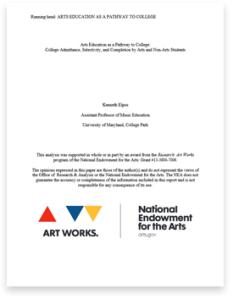
Author: Elpus, Kenneth
Publication Year:
Media Type: Report
Summary:
The existing research on the value and positive impact of adolescent involvement in the arts, while often examining generic academic benefits of K-12 arts study (e.g., Catterall, 1997; 2009; Deasy, 2002; Gouzouasis, Guhn, & Kishor, 2007; Helmrich, 2010; Miksza, 2007a; 2010; Morrison, 1994; Schellenberg, 2005; Southgate & Roscigno, 2009), has yet to specifically explore arts education as a pathway to college. The social and economic value of attending and completing college has been well documented in the research literature (Hout, 2012; Kane & Rouse, 1995; Marcotte, Bailey, Borkoski, & Kienzl, 2005); as such, it seems reasonable to investigate whether evidence exists suggesting arts education experiences might increase the probability that students will participate and succeed in the college admissions process and in the attainment of postsecondary credentials. The purpose of this study was to examine the value and positive impact of arts education on the college attainment of students in the United States.
Abstract:
Study Methodology: This study was designed to quasi - experimentally compare arts and non - arts students on a variety of outcomes related t to college admissions and attainment using a nationally representative sample of students from the U.S. graduating class of 2004. The sample was drawn from the U.S. Department of Education’s Education Longitudinal Study of 2002 (ELS), one of the periodic national longitudinal studies of secondary students conducted by the department’s National Center for Education Statistics (NCES), a center within the Institute for Education Sciences (Ingels et al., 2014) . ELS has collected data in four waves — initially in 2002 when most sample members were sophomores in high school; again in 2004 when most sample members were graduating seniors; again in 2006 when most sample members were two years past high school graduation, and most recently in 2012 when most sample m embers were aged 26. By tracking the same set of nationally representative sample members over time, ELS provides the most recent longitudinal view of high school students in the United States as they moved beyond high school into postsecondary education a nd the workforce. I identified arts and non - arts students in the sample through the analysis of the sample members’ complete high school transcripts, and also made use of the information in ELS’s rich set of demographic, academic, and extracurricular varia bles to help control for selection bias between the populations of arts and non - arts students. This control was achieved through holding these control variables constant through ordinary least squares, logistic, and ordered logistic regression procedures. [p.2-3]
Conclusions: Results from this study suggest that arts students are served well by their arts study when compared to non - arts students on outcomes related to college admission and attainment. Arts students were more likely than non - arts students to participate in the college admissions proces s — a necessary step on the pathway toward the attainment of a college degree and the attendant social and financial benefits that accrue to college graduates in American society — and applied to more schools than their non - arts peers. As would be predicted by their greater rates of participation in the college admissions process, arts students were also more likely than non - arts students to be attending a postsecondary institution two years past high school graduation. Unsurprisingly, high school arts students were considerably more likely than their non - arts peers to pursue arts majors in college. Perhaps more importantly than the areas in which arts students were advantaged in the college admission and attainment processes was the fact that in no outcome inve stigated were arts students significantly disadvantaged compared to their non - arts peers . Arts and non - arts students applied to selective colleges at similar rates, were admitted to selective colleges at similar rates, pursued majors in STEM fields at simi lar rates, earned bachelor’s degrees at similar rates and with similar rates of on - time completion, and received graduate degrees at similar rates. All of these similarities suggest that there is no “opportunity cost” to pursuing arts coursework in high sc hool at the expense of electing non - required, additional coursework in the STEM areas, in history or social studies, or in English and literature. Or, put another way, arts courses appearing on a high school transcript do not reflect poorly on students in the college admissions process . Guidance counselors, teacher mentors, and parents who try to restrict a student from the elective pursuit of arts coursework in high school for the fear of not creating a strong college resume are mistaken — there is no arts p enalty, and those students who would like to pursue arts coursework in high school should be encouraged to do so without fear of harming their chances in the college application, admission, and attainment processes. [p.5-6]
Arts & Intersections:
Categories: Creative Youth Development, Arts Education
ADDITIONAL BIBLIOGRAPHICAL INFORMATION
PUBLISHER INFORMATION
Name: National Endowment for the Arts
Website URL: http://www.arts.gov